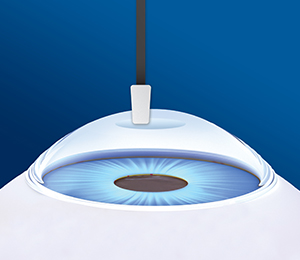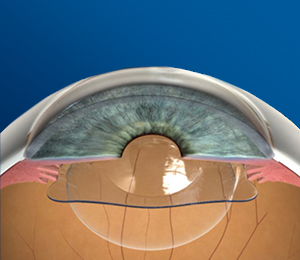
Stahl Vision has been providing a wide range of vision care services to the Dayton area for over 20 years!
Stahl Vision
4235 Indian Ripple Rd, Dayton, OH
PRK Laser Eye Surgery at Stahl Vision Laser Eye Center in Dayton Ohio
PRK Versus LASIK Which Should I Choose?
At a Glance: PRK, known medically as photorefractive keratectomy, is a type of laser eye surgery used for laser vision correction of nearsightedness, farsightedness and astigmatism. PRK takes longer to recover than LASIK, but is a better option for those with high prescriptions, thin corneas, or those likely to be hit in the eye (e.g. kick-boxers). CustomVision™ is a refinement in nomograms and wavefront laser eye surgery technology by Dr. Brian Stahl at Stahl Vision Dayton Ohio, to achieve high contrast vision and can be done with PRK.

How PRK works at our Ohio Center.
Some patients with thinner corneas, high prescriptions, or certain occupations may not be candidates for LASIK. For these patients PRK may be the best option. With PRK, the front surface is prepared by cleaning the front surface free of cells before applying the laser treatment. A bandage contact is worn afterwards for the first few days to allow healing of the surface. Vision improves several days after surgery once the surface cells have had some time to heal and recover after PRK. The vision results are equal to LASIK after several months, but it takes longer to recover and heal.
Upon the FDA approval of the Excimer Laser for Laser Eye Surgery, the initial treatments to correct common vision problems such as nearsightedness were performed using a procedure called PRK, which is known medically as Photorefractive Keratectomy.
For some selected patients, Photorefractive Keratectomy (PRK) is a procedure that offers those dependent on eyeglasses or a contact lenses the opportunity to be less dependent on or even eliminate their glasses and contact lenses.
In the Photorefractive Keratectomy (PRK) procedure, the Laser Eye Surgeons Drs. Stahl & Knowles begin by placing a few eye drops in your eyes to numb the surface of your eye. This is to make sure you are comfortable during your treatment. In fact, you should not experience any discomfort during your procedure. After entering the Excimer Laser Suite and reclining on the laser bed, laser eye surgeons Drs. Stahl & Knowles will carefully place a instrument between your eyelids to help you remember to keep them open during the PRK procedure.
Drs. Stahl & Knowles will first need to gently remove the outermost layer of the Cornea, which is called the epithelium. This can be done by the eye surgeon lightly applying an Amolis brush. By removing this thin layer, the eye surgeon can then apply the actual laser beam to the surface of the cornea where it will reshape the curvature in order to create the necessary change to correct your vision and eyeglass or contact lens prescription. The application of the laser is very precise as a computer controls each spot with an active tracking device. Your laser eye surgeon and staff will have programmed the laser based on their measurements and calculations gathered from your consultation. CustomVision™ is a refinement of Custom Wavefront laser eye surgery by Stahl Vision to achieve high contrast vision and can be done with PRK as well.
You should not be alarmed by the need to remove the thin epithelial layer in the PRK procedure as Drs. Stahl & Knowles will place a comfortable “bandage lens” in your eye after your treatment which is really just a very thin soft contact lens that helps your eye heal.
For some PRK patients, during the first day or so after the procedure, as the surface of your begins to begins to heal, they may experience a mild to moderate amount of discomfort which they tell us feels like “grittiness or sandiness”, almost like they have something under their contact lens. Drs. Stahl & Knowles may prescribe some additional eye drops to make your comfortable, control or reduce any inflammation that you may have as you heal, and/or to prevent any infection during the healing process.
FOllOW-UP CARE IS AN IMPORTANT PART OF YOUR SURGERY EXPERIENCE
Today, at Stahl Vision, Drs. Stahl & Knowles use the advanced technology of the Wavelight Allegretto Wave® Eye-Q Excimer Laser. This laser technology is distinctly different from the Excimer Laser systems used to perform PRK in the late 1990’s in that it actually measures the exact position of your eye hundreds of times during the treatment and adjusts the precise location of the application of the laser. In addition, rather than applying the laser in a “beam”, it delivers the laser to the surface of the eye in very small-less than 1.0mm-spots in pattern selected by the computer in order to obtain the smoothest treatment and best vision correction. By using this “scanning-tracking-spot technology,” PRK patients at Stahl Vision receive a smoother PRK surface treatment and experience a quicker and more comfortable visual recovery than others might have in the past. Likewise, improvements in the drops used after surgery and bandage contacts lenses have made PRK more comfortable, and resulted in faster healing.
While today Photorefractive Keratectomy (PRK) may only be recommended for a limited group of patients, it has an important place for those patients who have corneas that are too thin to have LASIK Eye Surgery, for those who have corneal scarring or irregularities making them unsuitable for LASIK surgery and for those who are involved in an activity that might result in direct contact with the surface of the eye.
During your Laser Eye Surgery consultation at Stahl Vision, our eye surgeons will thoroughly consider your individual lifestyle needs, eye health and vision requirements and help you select the best treatment option for your situation.
Monovision LASIK for Presbyopia & Near Vision Correction
As we get older we lose some of the ability to see up close, and about the time we reach 45 we are either wearing bifocals, wearing reading glasses, or for some patients taking our glasses off to read. For some patients, this loss of near vision called presbyopia may be corrected with monovision LASIK. Monovision LASIK here in Ohio is an FDA approved technique that corrects one eye for distance and one eye for near.

Using monovision LASIK addresses the need for two different focal lengths by focusing each eye at a different focal length. People over 40, who require glasses for distance vision – nearsighted or myopic individuals – frequently find that they can read up close quite well without their glasses. Correcting their distance vision to 20/20 almost always means that they will need glasses to be able to read up close. This is because they can no longer focus or adjust their focal length. Typically in monovision LASIK, the eye that is corrected for distance is the dominant eye and the eye that is corrected for near is the non-dominant eye. If monovision LASIK is a good choice for correcting your near vision, Dr. Stahl & Knowles Ohio LASIK surgeons, and the staff will make that recommendation for you and spend the time necessary to answer your questions.
Refractive Lens Exchange, Lens Replacement, or Clear Lensectomy with Advanced Lifestyle Bifocal Lens Implants
New Technology for Aging Eyes
For most patients wanting to see better without glasses, LASIK eye surgery is the most popular option in order to see distance. However, for patients who are over 50, especially those wanting to see better up close or those with early Cataracts, Refractive Lens Exchange may be a better option than LASIK. Imagine being able to see your world more like when you were younger, less dependent on glasses and contacts, or even reading glasses. Well, it may now be possible with refractive lens exchange or clear lensectomy. Stahl Vision and Eye Laser and Surgery Center is Dayton’s most experienced center for Refractive Lens Exchange, or as it is also known, Clear Lensectomy, or Lens Replacement Surgery.

Glossary: Refractive Lens Exchange RLE) is a synonym with Clear Lensectomy, or Lens Replacement Surgery. ReSTOR® , Multifocal Tecnis®, Symfony (said like “Symphony”) and Crystalens® are the names of Advanced Lifestyle Bifocal Implants or Premium Implant Lenses. These are types of bifocal implant lenses used with Refractive Lens Exchange as well as cataract surgery. These lenses are also know as intraocular lenses or IOLs. Presbyopia is the name of the condition that causes us to lose our near vision past the age of 40 something.LASIK is often the best vision correction choice for those with corneal shape or curvature problems that cause blurry vision. Conditions like nearsightedness (myopia), farsightedness (hyperopia) or astigmatism can be corrected with LASIK by changing the shape of the cornea according to a very precise treatment. Refractive Lens Exchange is a better option for vision correction for those who have a lens problem such as Presbyopia or Cataracts or who have extreme amounts of myopia, hyperopia, or astigmatism where LASIK would require the removal of too much tissue from the cornea to achieve your prescription.
At a Glance: Refractive Lens Exchange is becoming a more popular option for those over 50 seeking to regain their youthful vision! Refractive Lens Exchange is done at our ambulatory surgery center, Eye Laser and Surgery Center, as an outpatient procedure— you go in for your surgery in the morning, and go home a couple of hours later. Our center is in the same building as our office, so no hospitals, and we do it with no shots, and no stitches! One eye is done at a time, separated by a few weeks. Topical anesthesia with light sedation is all that is needed to keep the procedure pain free and comfortable. Best results are obtained after both eyes have been done to allow the eyes to work naturally together. This is the similar surgery as cataract surgery where the eyes natural lens is removed, and an artificial implant lens is put in its place. Choosing to have this surgery now means you won’t need cataract surgery later in life. The choice of which implant is best for you is something our surgeons will discuss with you after we determine the best range of vision for your lifestyle with the least amount of compromises. The best candidates for this procedure are over 50 years old, possibly with early cataracts, with otherwise healthy eyes, and who need glasses for both distance and near vision. For most patients living without their bifocals or reading glasses is something they have dreamt about.
Help for eyes that cannot focus up-close!
Before age 40 our lens is clear and flexible allowing us to focus on things at near. As we reach our mid-forties, everyone begins to experience the problem of our “arms becoming too short”, and near vision begins to fade. This condition is called presbyopia and gets progressively worse as we age. Eventually, we start wearing bifocals or reading glasses, or if you are nearsighted, begin to take our glasses off to read. Some patients will try monovision contacts, where one eye is set for distance, and one eye for near. This can be done with LASIK eye surgery as well, and monovision LASIK and is a good option for some patients, but it is a compromise— neither distance or near is as clear as it would be if both were set for that distance.
A second problem starts as we reach our fifties, about that time our lens starts to become slightly cloudy, and at this point Refractive Lens Exchange may become a better option than LASIK eye surgery. Patients wanting to see both distance and near more like when we were younger will do better with Refractive Lens Exchange. Eventually, this cloudiness within the lens progresses to the point where we don't see as well even with glasses. At this point, we call the cloudiness a Cataract, and if we all live long enough, we will all develop cataracts. Some early “baby cataract’ changes start occurring in our 50’s, but most patients are in their 60’s or 70’s before they have cataract surgery. Cataracts are a natural part of the aging process, but Refractive Lens Exchange can halt that, and this means you will not need cataract surgery later in life.
How to Decide Which Implant Lens is Right for You?
The best way to determine which Advanced Lifestyle Implant Lensthat is used for Refractive Lens Exchange is to come in for a complete eye exam. Once our surgeons have measured and examined your eyes, we can discuss your lifestyle and near vision needs and determine which Advance Lifestyle or Premium Implant is right for you. CLICK HERE TO LEARN ABOUT OUR LENS OPTIONS
FAQS
How is Refractive Lens Exchange or Lens Replacement Surgery different than LASIK Surgery?
LASIK Surgery can correct your distance vision, but NOT your near vision, unless you choose to have Monovision LASIK. LASIK remodels the surface of the eye, whereas Refractive Lens Exchange replaces the lens on the inside of the eye. LASIK is usually done on both eyes the same day, but with RLE we wait a few weeks in between surgeries.
What do I have to do after my Refractive Lens Exchange Surgery?
You will be using medicated eye drops for several weeks and need to take a couple of days off driving and work. Your distance vision clears quickly whereas adapting to your new found near vision will get better over several weeks.
Does this mean I won’t have to have Cataract Surgery later in life?
That is correct. This is the same surgery as Cataract Surgery but done to decrease your dependence on glasses. Your natural crystalline lens will be replaced with an artificial plastic implant lens and that means you won’t need cataract surgery later.
How much does this cost?
We charge $3900. This includes your surgery center costs, advanced implant lens charge, surgery fees and measurement fees as well as your after care for a year. Insurance does not cover RLE unless you have significantly bad cataracts, not just early cataracts. We offer several financing options with approved credit for Refractive Lens Exchange.
Our best eye surgeons Dr. Brian Stahl and Dr.James Knowles specialize in Refractive Lens Exchange with ReSTOR® , Multifocal Tecnis® and Crystalens® advanced bifocal implants. This can be an excellent solution to help regain the vision you deserve.
Please call Stahl Vision at 937.427.2020 to schedule an appointment to learn more about refractive lens exchange or for a refractive lens exchange evaluation and complete eye examination.
Our best laser eye surgeons Dr. Brian Stahl and Dr. James Knowles specialize in laser eye surgery, PRK plus LASIK, it is what we do!. Our Dayton, Ohio eye center puts Stahl Vision Center, Laser Vision Correction of Dayton, and Eye Laser and Cataract Surgery Center all under one roof conveniently located for patients from Sidney Ohio, Springfield Ohio, Urbana Ohio, Dayton Ohio, Cincinnati Ohio, West Chester Ohio, Eaton Ohio, Xenia Ohio, Jamestown Ohio, Franklin Ohio, Springboro Ohio, Waynesville Ohio, Lebanon Ohio, Mason Ohio, Oxford Ohio, and Middletown Ohio. Please call Stahl Vision at 937.643.2020 to schedule an appointment for an examination or consultation for PRK or CustomVision™ PRK.

